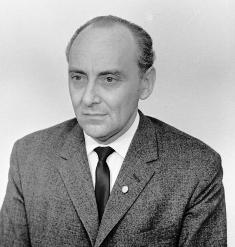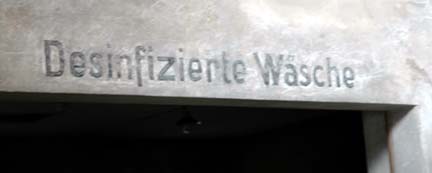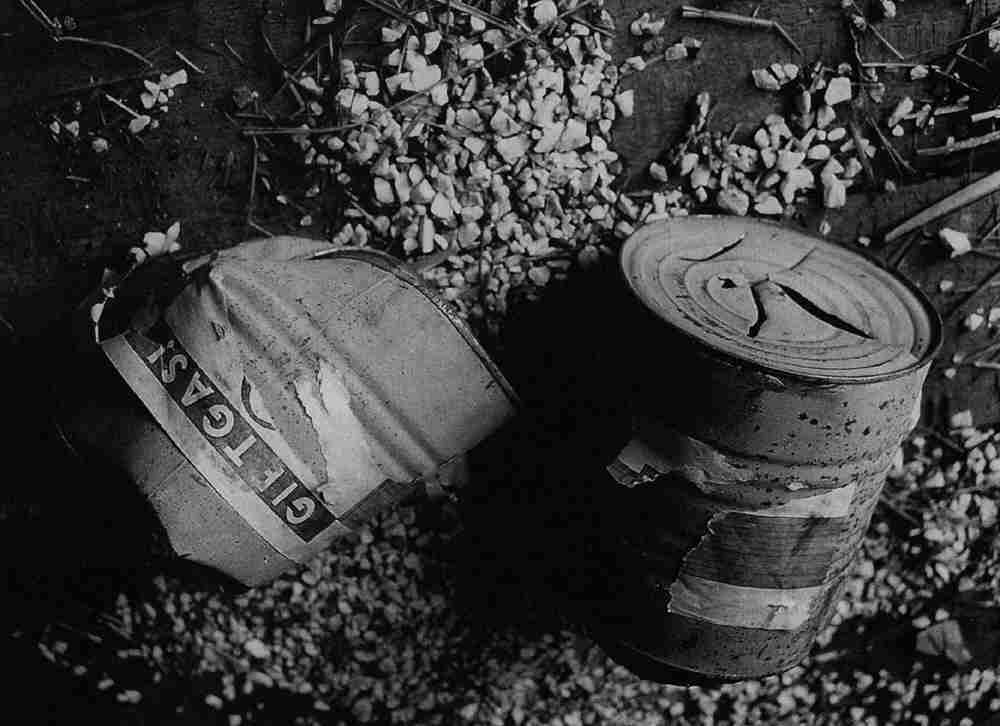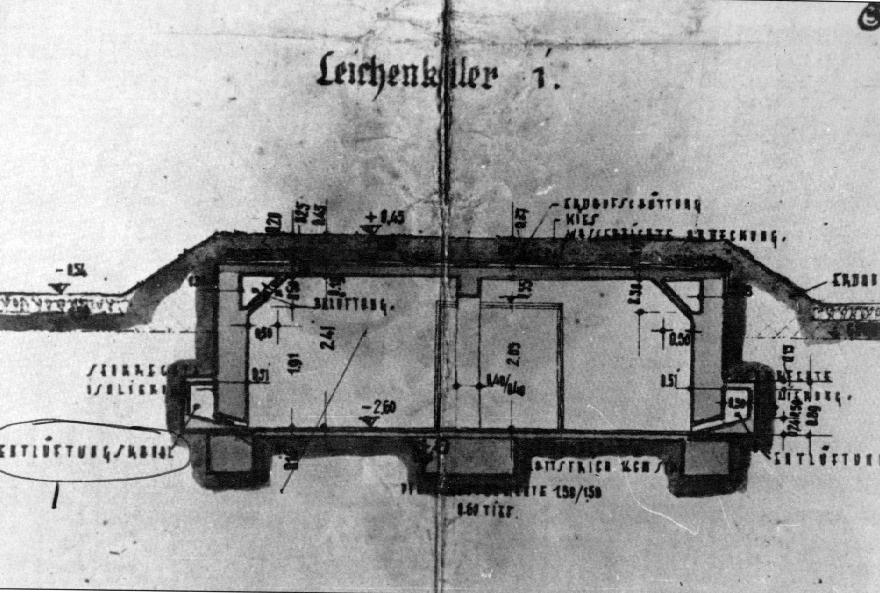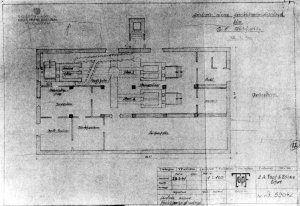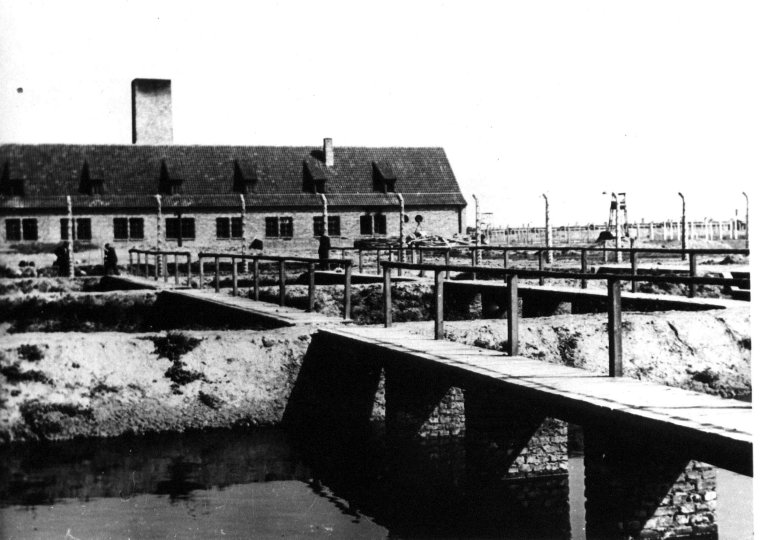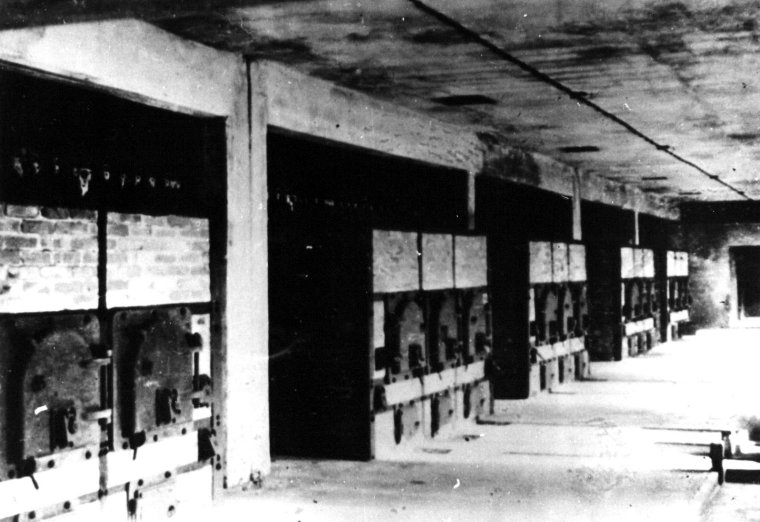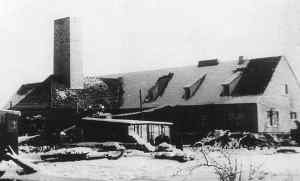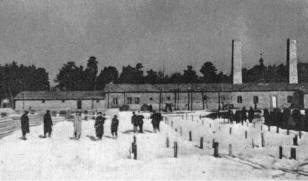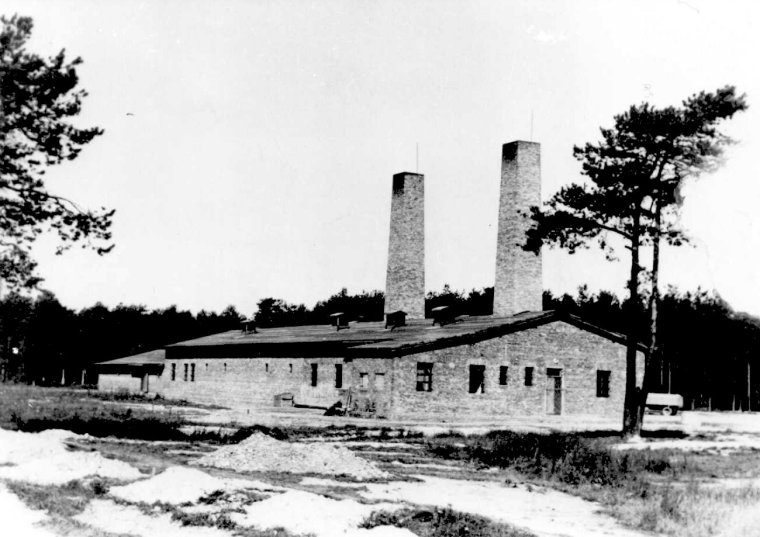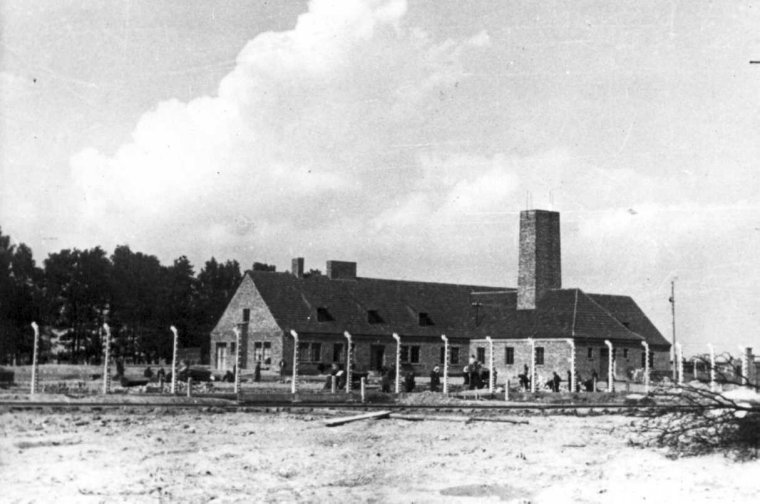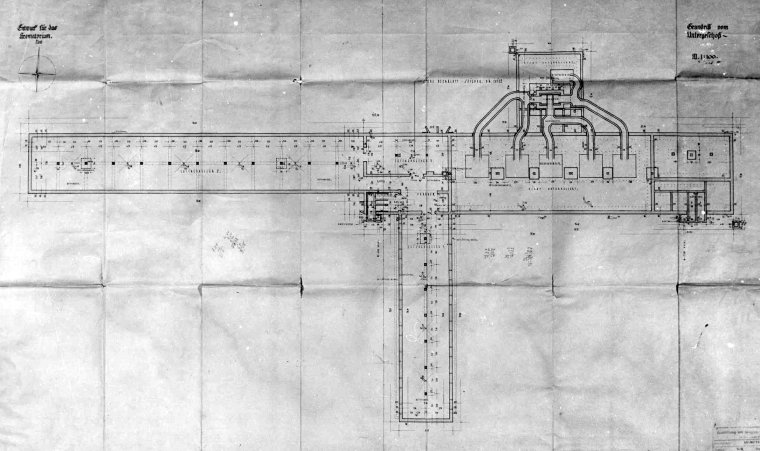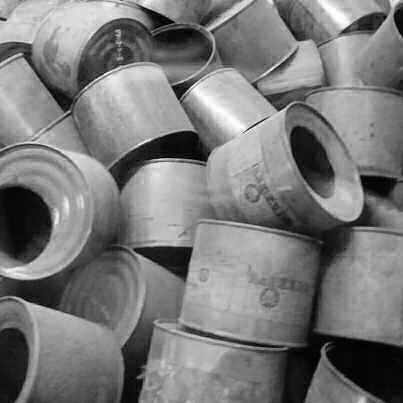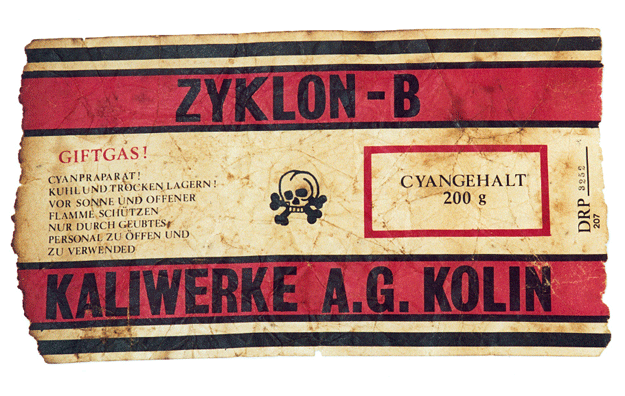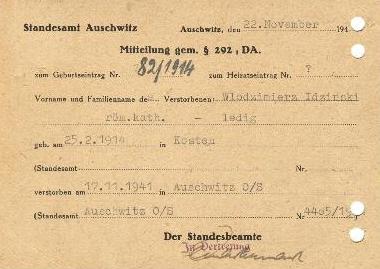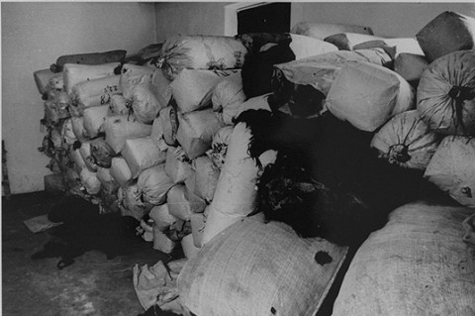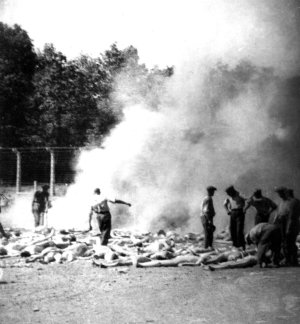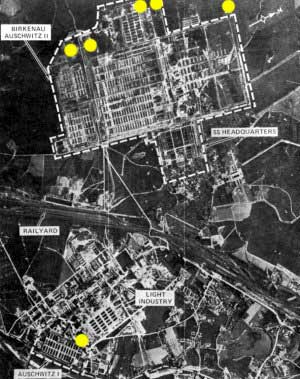Holocaust Education & Archive Research Team |
|
Other Camps
Key Nazi personalities in the Camp System The Labor & Extermination Camps
Auschwitz/Birkenau Jasenovac Klooga Majdanek Plaszow The Labor Camps
Trawniki
Concentration Camps
Transit Camps |
|||||||||||||||||||||||||||||||
Auschwitz Concentration Camp The Gas Chambers & Crematoria Mass Extermination
A special commission of doctors arrived in Auschwitz Concentration Camp on 28 July 1941, and select unfit prisoners mostly from Block 15 to be murdered in one of the Euthanasia killing centres.
Dr Horst Schumann, the director of the Euthanasia Centre at Sonnenstein, is one of the members of this commission.
Altogether 573 inmates, mostly Polish prisoners are selected, and two brutal Capos join the transport at the last moment. Ernst Krankemann, Capo of the road construction squad, and Johann Siegruth, the one-armed head Capo of the Lumber- yard.
Krankemann is murdered during the trip, Siegruth committed suicide, the rest were gassed at Sonnenstein euthanasia centre, in a bathroom where carbon monoxide gas was introduced through the showerheads.
In late August 1941 Lagerfuhrer Karl Fritzsch uses the gas Zyklon B to kill Russian Prisoners of War in the cellar of Block 11.
On 3 September 1941 following the success of the experimental gassing, the experiment was repeated in the cellar of Block 11.
In the bunker they are crammed together in a few cells. The cellar windows are blocked up with earth. Then about 600 Russian POW’s officers, and political commissars are driven into the cellar. As soon as they are pushed into the cells the SS men threw in the Zyklon B gas, the doors were locked and sealed.
On 4 September 1941 Roll-Call leader Gerhard Palitzsch protected by a gas mask opens the doors and discovers that one of the POW’s is still alive. More Zyklon B is poured and the doors are closed once more. On 5 September the prisoners of the penal colony and the orderlies of the camp hospital were summoned and taken to the courtyard of Block 11, for “special work”.
They were then ordered to don gas masks and taken down to the cellar where the gassing had been carried out. Thence they had to carry the bodies up to the courtyard, strip them of their military uniforms and then transport them to the crematorium. On 16 September 1941 900 Russian Prisoners of War are gassed in the morgue of the crematorium, and Commandant Hoss described this in his memoirs.
“While the transport was detraining, holes were pierced in the earth and concrete ceiling of the mortuary. The Russians were ordered to undress in an anteroom, then they quietly entered the mortuary, for they had been told they were to be deloused.
The whole transport exactly filled the mortuary to capacity – the doors were then sealed and the gas shaken down through the holes in the roof. I do not know how long the killing took. For a little while a humming sound could be heard – when the powder was thrown in, there were cries of gas, then a great bellowing and the trapped prisoners hurled themselves against both doors.
But the doors held, they were opened several hours later, so that the place could be aired.
The first transports of Jews arrived in the camp from Silesia at the beginning of 1942, on 15 February the first transport of Jews who have been arrested by the Gestapo arrived in Auschwitz from Beuthen. The Jews are gassed in the morgue beside the crematorium. The transport arrived by rail at the unloading ramp near the camp. From there they were escorted by the SS to the courtyard of the crematorium. In the meantime, all approach and transit roads were cleared and closed.
After undressing the victims were led into the morgue-cum- gas chamber – where they were told they were going to have a shower, after which they would receive a meal and be assigned to work.
The moment the gas was introduced, in order to drown out the screams and groans of the dying people, the motor of a lorry, parked there for this purpose, was switched on.
Initially the process of killing and ventilation of the gas chamber lasted several hours. Later, after the installation of ventilators, this period was shortened to about an hour.
After this time had elapsed, the prisoners of the crematorium squad proceeded to burn the corpses. All of this took place in the deepest secrecy, with participation limited to the minimum number of SS men from the camp command and the Political Department.
Among those who took part in these actions were Maximilian Grabner, Franz Hossler, and the disinfection expert Adolf Theuer.
The modest capacity of the crematorium, which could cope with 340 corpses in the space of 24 hours and the difficulty of keeping the whole action a secret, resulted in the operation being transferred to Birkenau.
A farmhouse belonging to one of the evacuated inhabitants of Birkenau, which Adolf Eichmann had identified during his first visit to Auschwitz, had its windows walled up, its doors strengthened and sealed by screwing them in place, and shafts drilled in the walls. The entrance door bore the inscription “To the Baths”, and on the inside of the exit door , which opened out into the open countryside, the inscription “To Disinfection” was emblazoned.
This completed the gas chamber known as Bunker 1 or the Red House, became operational on 20 March 1942. After the gassing had been completed the corpses were buried in mass graves in a nearby meadow. After each operation the prisoners used in the burial are killed in the prisoners infirmary by a phenol injection into the heart.
Transports intended for gassing were directed to the unloading ramp – known as the “old Judenrampe” of the goods station at Auschwitz whence they were led off to the bunker. From July 1942 incoming transports began to be submitted to selections.
After, the train was sealed off by a cordon of SS guards, the wagons were opened, the occupants told to get out and the selection process started immediately. The men were stood in one column along the ramp, the women and children in another.
This procedure was accompanied by the weeping and cries of people who, uncertain of their fate, were afraid of being parted from one another. The people had to approach the SS doctors in turn, whom decided on the basis of their external appearance on their fitness for work.
With a movement of his hand the doctor directed some to the right, and some to the left. Depending on the current need for labour, the young strong and healthy would be sent to the camp to work, while the rest – the sick,cripples, mothers with children, pregnant women and persons with a weak constitution were doomed to die.
With the help of stepladders they were loaded into waiting lorries and carried off to Bunker 1. If there was not enough room in the lorries for everyone, the remainder were led on foot across the meadows. In these meadows later on the huts of construction sector lll of the camp at Birkenau were to stand.
The escorting SS-men tried not to be provocative, on the contrary dispelling fears with false information about the fate that awaited them. People must have been re-assured by the outward appearance of the secluded cottage, especially in spring when the trees of the surrounding orchard were in bloom.
Upon arrival, the people were told of the baths and disinfection that awaited them and ordered them to undress in two huts reserved for this purpose, then they were led into the farmhouse. Individuals suspecting a trick, whose behaviour might evoke panic, were discreetly led behind the building and shot in the back of the head with low-calibre weapons.
The chamber, which was divided by two compartments, could admit 800 people at a time, and if the need arose considerably more were crammed in. Those who nevertheless could not be accommodated were shot immediately. After the doors were shut, bolted and screwed fast, specially trained SS disinfection experts introduced the gas Zyklon B in the form of small lumps of diatomite soaked in prussic acid.
Death of the people inside the gas chamber occurred after a few minutes as a result of internal suffocation caused by the prussic acid halting the exchange of oxygen between the blood and tissues.
Those standing near the shafts died almost instantly, those who shouted, the old, the sick and children also died a quicker death.
In order to ensure that no one remained alive, the gas chamber was not opened until half an hour had elapsed. In periods when the pressure of incoming transports was particularly intense, the gassing time was shortened to ten minutes.
Most of the corpses were found near the door through which the victims had tried to escape from the spreading gas. The corpses, which covered the entire floor of the gas chamber, had their knees half bent, and were often cloven together. The bodies were smeared with excrement, vomit and blood. The skin assumed a pink hue.
Following ventilation of the gas chamber, the corpses were removed, loaded onto iron wagons and transported by a narrow-gauge railway for a distance of several hundred meters and there buried in deep pits. All the personal belongings the people had brought with them had to be left at the “Judenrampe”- the owners were told that their things would be sent on to the camp separately.
These belongings were gathered up by prisoners of a special commando known in the camp jargon as the “Canada” commando, were loaded onto waiting lorries and taken to special warehouses, initially there were five, but towards the end of the camps existence there were thirty huts.
There the belongings were examined, sorted, cleaned and disinfected, before being shipped off, to the Reich, for distribution among the German people, and Volksdeutsche who had settled in the General- Government.
Due to the increased number of Jewish transports to Auschwitz another farmhouse was converted, west of the later site of Crematoriums IV and V and is designated Bunker Number 2 or the White House. Next to it three barracks are built to serve as undressing rooms for people condemned to death.
This chamber contained four compartments in which it was possible to gas 1,200 people at a time. It was this chamber, which was used to show Himmler the whole gassing procedure, in July 1942.
Following a visit to the death camp at Chelmno in September 1942 to witness the technique used to dispose of corpses by burning on pyres this process was introduced towards the end of September 1942.
The bodies of the newly gassed began to be burned on pyres on which layers of 2000 corpses each alternated with layers of kindling. At the same time the exhumation and burning of bodies already buried in the mass graves was started.
On 19 January 1942 SS Sergeant Ulmer of the Central Construction Administration of Auschwitz completed the plans for the construction of Crematoria ll and lll in Birkenau, which commenced in the summer of 1942. These buildings had undressing and gas chambers underground.
Plans for two further gas chamber and crematoria IV and V were completed on 11 January 1943, in these two installations the undressing halls and gas chambers were on the same level as the crematorium.
* Details from Auschwitz Chronicle – Danuta Czech
Work on construction of the crematoria begun in July 1942 and continued at an accelerated pace until the middle of the following year. Several hundred prisoners on day and night shifts were employed building them.
The first to be completed on 22 March 1943 was Crematorium IV, the next Crematorium II was ready on 31 March 1943, followed by Crematorium V on 4 April 1943 and Crematorium III on 25 June 1943.
Crematorium II and III, identical in construction, possessed five three-door furnaces with two generator hearths in each furnace. Crematorium IV and V, on the other hand , had one eight –door furnace.
Before the Crematoria were officially commissioned, on 4 and 5 March 1943, in the presence of high-ranking SS officers from Berlin, representatives of the camp authorities and engineers and employees of the firm Topf und Sohne, a test of Crematorium II was held.
Prisoners of the Sonderkommando who had been acquainted with the functioning of crematorium installations by a Capo brought from the Buchenwald Concentration Camp crematorium. August Bruck on the morning of the 4 March 1943 lit the burners of the generators and maintained the fire in them until four o’clock in the afternoon.
Next, in the presence of the above- mentioned commission who, watch in hand, were following the course of the test, three corpses were placed in each retort. Because, contrary to expectations, it took as long as forty minutes to burn them, orders were given for the ovens to be heated for a fortnight.
In practice the capacity was twice as high- in Crematorium II and III, 5000 corpses were disposed of every twenty-four hours, and in Crematorium IV and V up to 3000.
Henceforth bodies were burned in the open only when there was an influx of particularly large transports and the crematoria were unable to keep pace with the work of extermination.
The highest daily number of people gassed and cremated actually achieved in 1944 during the extermination of the Hungarian Jews was 24,000.
At that time Bunker 2 was reactivated, the old burning pits reopened, an additional five large pits were dug around Crematorium V, and the railway onto which the transports were shunted was extended right up to the crematoria themselves.
Dr Nyiszli described the additional facilities the Nazis re-introduced to deal with the Hungarian transports:
“ Our path took us past the crematoriums- after showing the SS guard our safe conduct, we passed through an opening cut in the barbed wire and reached an open road. We crossed a clearing and came to a small pine forest. Once again we found our way blocked by a fence and gate strung with barbed wire. A large sign, similar to those on the crematorium gates, was posted here:
Entrance is strictly forbidden to all those who have no business here, including SS personnel not assigned to this command.
In spite of this sign we entered without the guards even asking – passing through the gate, we reached an open place which resembled a courtyard, in the middle of which stood a thatched –roof house whose plaster was peeling off. Its style was that of a typical German country house, and its small windows were covered with planks. As a matter of fact, it no doubt had been a country house for at least 150 years, to judge by its thatched roof, which had long turned black, and its often-replastered flaking walls.
It was now used as an undressing room for those on their way to the pyre. It was here that they deposited their shabby clothes, their glasses, and their shoes.
Behind the house enormous columns of smoke rose skyward, diffusing the odour of broiled flesh and burning hair. In the courtyard a terrified crowd of about 5000 souls- on all sides thick cordons of SS, holding leashed police dogs.
The prisoners were led, three or four hundred at a time, into the undressing room. There hustled by a rain of truncheon blows, they spread out their clothes, and left by the door at the opposite side of the house, yielding their places to those who were to follow.
Once out of the door they had no time to glance around them or to realise the horror of their situation. A Sonderkommando immediately seized their arms and steered them between the double row of SS who lined the twisting path, which flanked on either side by woods, ran for fifty yards to the pyre, which till now had been hidden by the trees.
The pyre was a ditch fifty yards long, six yards wide, and three yards deep, a welter of burning bodies, SS soldiers stationed at five-yard intervals along the pathway side of the ditch, awaited their victims.
They were holding small calibre arms – six millimetres – used in the KZ for administering a bullet in the back of the neck. At the end of the pathway two Sonderkommando men seized the victims by the arms and dragged them for 15 or 20 yards into position before the SS.
Their cries of terror covered the sound of shots.
A shot, then immediately afterwards even before he was dead, the victim was hurled into the flames. Fifty yards farther a scene similar in all respects was being enacted. Oberscharfuhrer Moll was in charge of these butchers.
Here the majority of the men were thrown alive into the flames – woe to any Sonderkommando by whose actions the living chain, which extended from the cloakroom to the pyre, was broken, with the result that one of the members of the firing squad was forced to wait for a few seconds before receiving his new victim.
Moll was everywhere at once – he made his way tirelessly from one pyre to the next, to the cloakroom and back again. Most of the time the deportees allowed themselves to be led without resistance. So paralysed were they with fright and terror that they no longer realised what was about to happen to them.
The majority of the elderly and the children reacted in this way. There were, however, a goodly number of adolescents among those brought here, who instinctively tried to resist with a strength born of despair.
If Moll happened to witness such a scene, he took his gun from his holster. A shot, a bullet often fired from a distance of 40 to 50 yards, and the struggling person fell dead in the arms of the Sonderkommando who was dragging him towards the pyre.
Moll was an ace shot – his bullets even pierced the arms of the Sonderkommando men from one side to the other when he was dissatisfied with their work.
Each of these modern crematoria was surrounded by a barbed wire fence, possessed a separate entrance and was concealed on the camp side by a wicker fence. Neatly tended flower- beds gave the whole place an innocent appearance.
The gas chambers and undressing rooms attached to Crematorium II and III were underground. On the walls of the spacious undressing room were, apart from the appropriate notices, numbered pegs to hang clothes on with benches under them, while the gas chambers had piping and imitation shower sprays.
People entering the chambers – first women with children, followed by men – were led to the opposite wall, behind a cordon of SS-men standing in front of it. As the gas chamber filled up, the latter withdrew towards the door. In this way 3000 people would be crammed into a gas chamber with a floor space of 210 square meters – 30 meters long by 7 meters wide and 2.4 meters high.
In Crematorium IV and V, for reasons of economy, the gas chambers had not been built underground but on the surface. Each of these chambers had been originally divided into three, later into four compartments, containing 1500, 800, 800 and 150 people respectively.
As in the bunkers, the gas shafts in the gas chambers attached to crematoria IV and V were in the side walls. In the gas chambers attached to crematoria II and III the gas was introduced through openings in the ceiling which led into special pillars made of thick wire netting and with a movable core, which reached to the floor.
The SS disinfector opened a tin of Zyklon B and threw its contents into a special separating cone thanks to which the lumps of diatomite distributed themselves evenly inside the core of the mesh pillar, which hastened the process of gassing.
From 6 to 12 kilograms of gas would be introduced into the gas chamber at a time- in the years 1942-1943 19.652.69 kilograms of Zyklon B were delivered to Auschwitz by the firm Tesch und Stabenow.
Through a special spy-hole in the door the SS doctor supervising the gassing could observe the interior of the chamber.
Rudolf Hoss described one such gassing:
“ Through the spyhole in the door one could see how those persons standing nearest the shafts fell dead immediately. Nearly a third of the victims died instantaneously. The others began to huddle together, scream and gasp for air. Soon however, the screams turned into a death rattle, and a few minutes later all were lying down. By the time twenty minutes at the most had passed, no one was moving”.
Filip Muller a member of the Sonderkommando described a gassing:
“As people reached the crematorium they saw everything – this horribly violent scene. The whole area was ringed with SS. Dogs barked – machine- guns. They all, mainly the Polish Jews, had misgivings.
They knew something was seriously amiss, but none of them had the faintest of notions that in three or four hours they’d be reduced to ashes.
When they reached the undressing room they saw that it looked like an International Information Centre. On the walls were hooks,and each hook had a number. Beneath the hooks were wooden benches. So people could undress more comfortably, it was said.
And on the numerous pillars that held up this underground undressing room, there were signs with slogans in several languages – “Clean is Good”,” Lice can kill”, “Wash Yourself”, “To the disinfection area”. All those signs were only there to lure people into the gas chambers already undressed – and to the left, at a right angle, was the gas chamber with its massive door.
In Crematoriums II and III, Zyklon B gas crystals were poured in by a so-called SS disinfection squad through the ceiling, and in Crematorium IV and V through side openings. With five or six canisters of gas they could kill around two thousand people.
This so-called disinfection squad arrived in a truck marked with a red cross and escorted people along to make them believe they were being led to take a bath. But the red cross was only a mask to hide the canisters of Zyklon B gas and the hammers to open them.
The gas took about fifteen minutes to kill. The most horrible thing was when the doors of the gas chambers were opened – the unbearable sight – people were packed together like basalt, like blocks of stone. How they tumbled out of the gas chamber.
I saw that several times- that was the toughest thing to take – you could never get used to that. It was impossible.
You see, once the gas was poured in, it worked like this: it rose from the ground upwards. And in the terrible struggle that followed – because it was a struggle – the lights were switched off in the gas chambers. It was dark, no one could see, so the strongest people tried to climb higher. Because they probably realised that the higher they got, the more air there was. They could breathe better. That caused the struggle.
Secondly, most people tried to push their way to the door. It was psychological – they knew where the door was, maybe they could force their way out. It was instinctive, a death struggle. Which is why children and weaker people, and the aged, always wound up at the bottom. The strongest were on top. Because in the death struggle, a father didn’t realise his son lay beneath him”.
And when the doors were opened?
"They fell out. People fell out like blocks of stone, like rocks falling out of a truck. But near the Zyklon B gas, there was a void. There was no one where the gas crystals went in – An empty space. Probably the victims realised that the gas worked strongest there. The people were battered – they struggled and fought in the darkness. They were covered in excrement, in blood, from ears and noses."
"One also sometimes saw that the people lying on the ground, because of the pressure of the others, were unrecognizable. Children had their skulls crushed. It was awful, Vomit, Blood – from ears and noses, probably even menstrual fluid. I am sure of it.
There was everything in that struggle for life, that death struggle. It was terrible to see. That was the toughest part."
"It was impossible to save people. One day in 1943 when I was already in Crematorium V, a train from Bialystok arrived. A prisoner on the Sonderkommando saw a woman in the undressing room, who was the wife of a friend of his.
He came right out and told her – “You are going to be exterminated. In three hours you’ll be ashes”. The woman believed him because she knew him. She ran all over and warned the other women – “ We’re going to be killed. We’re going to be gassed”.
Mothers carrying their children on their shoulders did not want to hear that.
They decided the women was crazy. They chased her away. So she went to the men. To no avail. Not that they did not believe her- they’d heard rumours in the Bialystok ghetto or in Grodno and elsewhere. But who wanted to hear that.
When she saw that no one would listen, she scratched her whole face. Out of despair. In shock- she started to scream.
So what happened?
Everyone was gassed. The woman was held back – we had to line up in front of the ovens. First they tortured her horribly because she would not betray him. In the end she pointed to him. He was taken out of the line and thrown alive into the oven. We were told “Whoever tells anything will end like that”.
After the ventilators were switched on and the gas removed from the chamber, the doors were opened and the corpses dragged out and raised in an electric goods elevator to the crematorium building which was at ground level. Next after the hair had been cut off and the gold teeth removed, the corpses were dragged up to the ovens and laid on special trolleys, which were then pushed inside.
The period of cremation lasted about twenty minutes – the ashes and remains of bones were ground down in special grinders and thrown into rivers or carried away in lorries to the village of Harmeze where they were thrown into fish ponds, scattered in the swamps or used to fertilize the fields of the camps farms.
The gold teeth extracted from the corpses were melted down on the spot in a special melting pot installed in crematorium III and in some periods the daily haul came to as much as 12 kilograms. The crematorium roofs, warmed by the ovens below, were used for drying the hair of the murdered victims.
Dr Miklos Nyiszli describes his transfer to the commando of the living dead:
“ For about twelve minutes we drove through the labyrinth of barbed wire and entered well-guarded gates, thus passing from one section to another. Only then did I realise how vast the KZ was.
Dr Mengele suddenly interrupted my meditations. Without turning, he said: “The place I am taking you to is no sanatorium, but you’ll find the conditions there are not too bad.”
We left the camp and skirted the Jewish unloading ramp for about 300 yards. A large armoured gate in the barbed wire opened behind the guard. We went in: before us lay a spacious courtyard, covered with green grass.
The gravel paths and the shade of the pine trees would have made the place quite pleasant had there not been, at the end of the courtyard, an enormous red brick building and a chimney spitting flame. We were in one of the crematoriums. We stayed in the car, an SS man ran up and saluted Dr Mengele. Then we got out, crossed the courtyard and went through a large door into the crematorium.
“Is the room ready?” Dr Mengele asked the guard.
“Yes sir”, the man replied.
We headed towards it, Dr Mengele leading the way. The room in question was freshly whitewashed and well lit by a large window, which however, was barred. The furnishings, after those of the barracks surprised me: a white bed, a closet, a large table and some chairs. On the table, was a red velvet tablecloth.
The concrete floor was covered with handsome rugs. The Sonderkommando men had painted the room and outfitted it with objects that the preceding convoys had left behind.
We then passed through a dark corridor until we reached another room, a very bright, completely modern dissecting room, with two windows. The floor was of red concrete and in the centre of the room, mounted on a concrete base, stood a dissecting table of polished marble, equipped with several drainage channels. At the edge of the table, a basin with nickel taps had been installed. Against the wall stood three porcelain sinks. The walls were painted a light green, and large barred windows were covered with green metal screens to keep out flies and mosquitoes.
We left the dissecting room for the next room: the work room. Here there were fancy chairs and paintings – in the middle of the room, a large table covered with a green cloth- all about comfortable armchairs.
I counted three microscopes on the table. In one corner there was a well-stocked library, which contained the most recent editions. In another corner a closet, in which were stored white smocks, aprons, towels and rubber gloves. In short the exact replica of any large city’s institute of pathology.
I returned to my room and sat down.
More visitors arrived, men in civilian clothes, clean- shaven and smartly dressed. The Capo- in –Chief and two of his men entered my room. This too was a courtesy call. They had heard about my arrival and invited me to dine with them and meet the other prisoners.
I followed them up the stairs to the second story of the crematorium where the prisoners lived- an enormous room, with comfortable bunks lining both walls. The bunks were made of un-painted wood, but on each one silk coverlets and embroidered pillows shone. This colourful expensive bedding was completely out of keeping with the atmosphere of the place.
The whole room was bathed in dazzling light, for here they did not economise on electricity as they did in the barracks. Our way led between the long row of bunks. Only half the commando was present, the other half was on the night shift. Some of those here were already in bed asleep, while others were reading. There were plenty of books to be had, for we Jews are a people who like to read.
The table awaiting us was covered with a heavy silk brocade tablecloth: fine initialled porcelain dishes and place settings of silver. The table was piled high with choice and varied dishes, everything a deported people could carry with them – all sorts of preserves, bacon, jellies, several kinds of salami, cakes and chocolate. From the labels I noticed that some of the food had belonged to Hungarian deportees.
All these auxillary operations were carried out by the prisoners of the Sonderkommando under the supervision of SS men. In the years 1942-1945 the post of Crematorium Chief was held consecutively by:
The Sonderkommando were chosen chiefly from among Jewish prisoners of the countries from which current transports were arriving. Their number varied with the size and frequency of transports for extermination.
In order to isolate them from the other prisoners the members of the Sonderkommando were quartered separately – in the main camp in the cellars of Block 11, and at Birkenau in a block specially set aside for them, and from mid-1944 over the crematoria.
In the event of any refusal to carry out their grisly tasks they were killed at once. On 22 July 1944, 435 young Greek Jews were gassed for refusing to work in the Sonderkommando.
The first Sonderkommando – numbering about eighty prisoners – which had been employed to bury the bodies of those gassed in Bunkers 1 and 2, were liquidated in August 1942.
The second – numbering some 150 – 300 prisoners employed at the same site, as those above, were gassed on 3 December 1942 in the gas chambers attached to Crematorium 1 in the main camp at Auschwitz.
The Sonderkommando reached its largest complement – of about 1000 prisoners – in the early summer of 1944 during the peak period of the extermination of the Hungarian Jews. On 30 August 1944 – 874 prisoners worked in two shifts in the four crematoria at Birkenau.
As the number of transports sent to the camp for extermination fell in the late summer of 1944 , it was decided to liquidate gradually the members of the Sonderkommando.
On 23 September 1944 about 200 of them were sent from Birkenau to the main camp at Auschwitz where they were gassed by a ruse in a chamber hitherto never used for this purpose. The selected prisoners received food supplies and were loaded onto freight cars that were standing on a siding in Birkenau.
Rather than departing for Gleiwtz as promised, the train moved to a siding near Auschwitz main camp. Here the members of the Sonderkommando are led to a very large building in which clothing and other goods were disinfected.
Their particulars are recorded as if they were new arrivals – in the evening the supervisor of the Special Squad, SS- Hauptscharfuhrer Otto Moll, and the other SS guards watching them drink schnapps, which they offered to the prisoners. As soon as the prisoners were drunk , the room they were in was locked from the outside. Zyklon B was thrown in through a window, which killed them. News of this gassing despite the secrecy, reached the surviving members of the Sonderkommando, who began to prepare for an uprising.
When an attempt was made to liquidate a second batch on 7 October 1944 a revolt broke out during which several hundred prisoners were either killed fighting or murdered.
By 9 October 1944 the Sonderkommando numbered only 212 prisoners. The next day fourteen of them were arrested and placed in the bunkers of Block 11 in the Auschwitz main camp. Among them was one of the organisers of the revolt – Jankiel Handelsman of Radom. The remaining 198 prisoners were employed in Crematoriums II, III, and V, Crematorium IV was damaged, beyond repair during the revolt.
In the last period of the camps existence the prisoners of the Sonderkommando were used to remove traces of the crime. In October 1944 they were employed in pulling down the walls of the burnt out crematorium IV, and in November 1944 they dismantled the technical installations of the gas chamber and ovens in crematoria II and III which were then blown up.
On 26 November 100 prisoners of the 200 Sonderkommando were chosen and allegedly sent to the Gross Rosen concentration camp – their fate remains unknown.
On 5 January 1945 six members of the Sonderkommando were dispatched to Mauthausen concentration camp where they were shot, thirty remained to man the last functioning crematorium V, and seventy were employed in clearing out and filling –in the burning pits.
On 20 January 1945 an SS division under SS – Corporal Perschel destroys Crematorium II and III and abandons the camp. On 26 January an SS squad blows up Crematorium V, the last of the crematoriums in Birkenau.
Lastly, a Polish report in 1946 by Dr Philip Friedman and Tadeusz discovered the use of a gas –van at Auschwitz, used to liquidate people sentenced to death by the special police court, which convened throughout the war at Auschwitz.
The relevant part in the report has been translated:
To kill small groups of prisoners (up to 30 people) in 1944 they introduced special lorry-gas chamber. Special report of secret organization dated 21.09.1944 describes that. (I do not know why the date is earlier than 1944):
“ In the sandy area (close to Maczki?) is located so called Sonderkomando Rycyrk – special lorry-gas chamber and plough. This lorry (Saurer) Pol 71-462, yellow-green was constructed on the special way, it included 4 m long and 2,5 wide chamber, steel plated inside, with door without handles, floor – trap door and grated window in the right corner to let in the fresh air. This lorry has at the back the pipe to which another pipe may be connected when necessary. When the engine was started the fumes were killing people inside. The plough was used for digging and burring the victims.
This Kommando was created in Russia to kill dangerous ‘elements’ (people) in the areas close to the front line. Then it arrived from Lithuania and served in Oswiecim under the direction of Polizei Standesgericht. There are other witnesses of similar killings in Oswiecim, who have seen the driver Arndt walking around this lorry and smiling: “my birds are being smoked inside”
Sources:
Auschwitz Nazi Extermination Camp – Interpress Publishers Warsaw 1985 Auschwitz Chronicle – by Danuta Czech, Henry Holt & Company, New York 1989 Oswiecim by Dr Filip Freidman & Tadeusz Holuj 1946 Spoldzielnia Wydawnicza – Ksiazka – supplied from the private archive of Zdzislaw Lorek Auschwitz by Dr Miklos Nyiszli, published by Granada Publishing Ltd 1973 Shoah, by Claude Lanzmann, published by Pantheon Books, New York1985 Auschwitz Museum
Special thanks to P.K for translation work on the Friedman and Tadeusz report.
Copyright SJ H.E.A.R.T 2007
|

